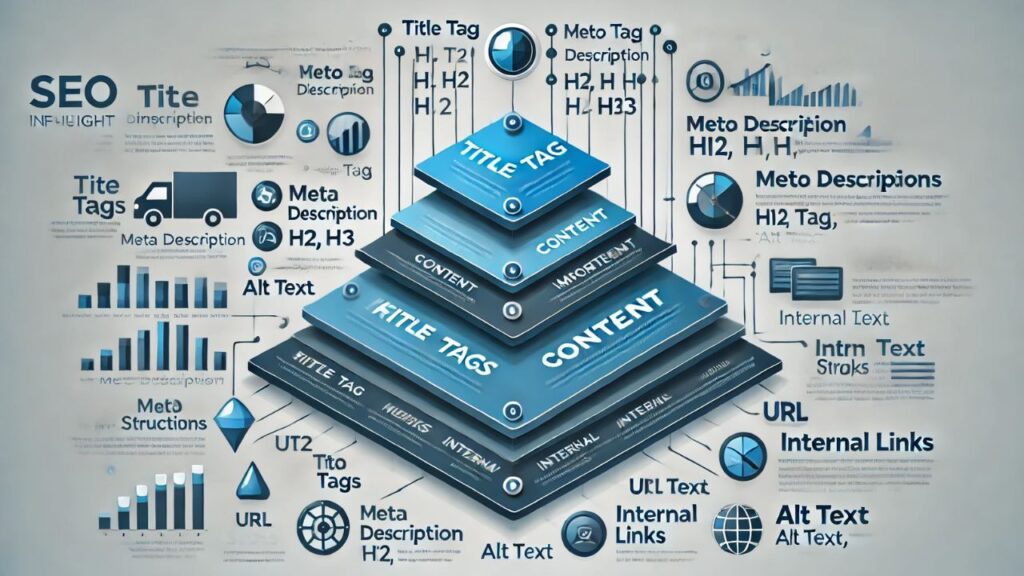Search Engine Optimization (SEO) is the foundation of digital visibility, and mastering its intricacies begins with understanding on-page SEO. Among the many strategies that improve a website’s ranking, focusing on on-page SEO elements is one of the most controllable and impactful ways to optimize your content for search engines and users. But which on page element carries the most weight for SEO?
Table of Contents
Understanding On-Page SEO Elements
On-page SEO refers to the process of optimizing the elements within a webpage to improve its search engine rankings. These optimizations are entirely within your control, as they revolve around the structure, content, and technical setup of your website. Search engines like Google use these on-page elements to evaluate the relevance and quality of a webpage in response to user queries.
Key on-page elements include:
- Title Tags
- Meta Descriptions
- Headings (H1, H2, etc.)
- URL Structure
- Content Quality and Relevance
- Internal Links
- Keyword Placement
- Image Optimization
- Page Speed and Mobile Friendliness
Each of these factors contributes to the overall SEO performance of a webpage. However, their individual importance varies based on search engine algorithms and user behavior trends.
Title Tags: A Cornerstone of On-Page SEO
The title tag is often regarded as one of the most critical on-page elements for SEO. It appears as the clickable headline on search engine results pages (SERPs) and tells both users and search engines what the page is about.
Why Title Tags Are Important:
- Direct Impact on Rankings: Search engines analyze title tags to understand the content of a page. Including relevant keywords in the title tag can signal the relevance of the page to a user’s search query.
- Improved Click-Through Rate (CTR): A compelling, well-crafted title tag entices users to click on your link over competitors. Higher CTRs can, in turn, positively impact rankings.
- Keyword Placement: Placing primary keywords toward the beginning of the title tag can enhance visibility and relevance.
Best Practices for Title Tags:
- Keep it under 60 characters to avoid truncation in search results.
- Use the primary keyword naturally and ensure the title is descriptive.
- Avoid keyword stuffing, as this can harm user experience and lead to penalties.
While the title tag is undeniably influential, it works best when paired with other well-optimized elements.
Content Quality: The Most Weighted Element
When discussing which on page element carries the most weight for SEO, content quality often emerges as the top contender. Search engines aim to deliver valuable, relevant, and authoritative content to users, making high-quality content the foundation of any successful SEO strategy.
What Defines High-Quality Content?
- Relevance: Content should directly address the intent behind a user’s query. Whether informational, navigational, or transactional, understanding search intent is critical.
- Depth: In-depth content that thoroughly covers a topic often outranks superficial or thin content. Comprehensive guides, FAQs, and detailed breakdowns are excellent examples of content depth.
- Originality: Search engines prioritize unique content. Duplicate content, whether across your site or from external sources, can lead to penalties or lower rankings.
- Readability: Content should be easy to read, with clear headings, short paragraphs, bullet points, and a conversational tone.
Content Optimization Tips:
- Focus on primary and secondary keywords while maintaining natural language.
- Use semantically related keywords (LSI keywords) to enhance context.
- Include internal links to other relevant pages on your site to provide additional value to users.
Content remains at the heart of on-page SEO because it directly engages users, encourages longer dwell times, and provides the information users are searching for.
Heading Tags: Structuring Your Content
Heading tags (H1, H2, H3, etc.) provide structure to your content and help search engines understand its hierarchy and organization.
Importance of Headings for SEO:
- Improved Readability: Headings break up large chunks of text, making it easier for users to navigate your content.
- Keyword Relevance: Incorporating keywords into headings, especially the H1 tag, signals the content’s relevance to search queries.
- Search Engine Context: Headings help search engines understand the main topics of a page, improving its chances of ranking for relevant keywords.
Best Practices for Headings:
- Use only one H1 tag per page, typically as the main title.
- Incorporate keywords naturally into headings.
- Ensure subheadings (H2, H3, etc.) are organized logically to guide users and search engines.
While heading tags play a significant role in content structuring and SEO, they complement other on-page factors rather than dominating the ranking equation.
Meta Descriptions: Driving CTR
Although meta descriptions do not directly influence rankings, they are a key factor in encouraging clicks. This HTML element appears below the title tag in SERPs and provides a brief summary of the page content.
Why Meta Descriptions Matter:
- Enhanced CTR: A compelling meta description encourages users to click on your link, indirectly affecting rankings by increasing engagement.
- Relevance Signals: Meta descriptions containing relevant keywords highlight the page’s relevance to a query.
Meta Description Tips:
- Keep it concise (around 150–160 characters).
- Include the primary keyword naturally.
- Write an engaging and accurate summary of the page content.
While meta descriptions may not carry as much direct SEO weight as title tags or content, their role in CTR and user engagement cannot be overlooked.
URL Structure: Building a Strong Foundation
A clear and optimized URL structure improves user experience and search engine understanding.
Benefits of Optimized URLs:
- Keyword Relevance: Including target keywords in the URL helps search engines associate the page with specific queries.
- Improved Navigation: Clean, descriptive URLs enhance usability for both users and search engines.
- Hierarchy Signaling: URLs that follow a logical structure help search engines understand site hierarchy.
Best Practices for URLs:
- Use hyphens to separate words for readability.
- Avoid long or complicated URLs.
- Include a primary keyword while keeping the URL concise and descriptive.
While URLs play a supporting role, they contribute to the overall SEO framework when combined with other elements.
Image Optimization: Visual and Technical Value

Images enhance the user experience but must be optimized to avoid hindering page performance.
Key Aspects of Image Optimization:
- Alt Text: Including descriptive alt text with keywords helps search engines understand image content and improves accessibility.
- File Size: Compressing images reduces page load time, improving site performance.
- File Names: Descriptive file names with keywords provide additional relevance signals.
Image Optimization Tips:
- Use formats like JPEG or WebP for faster loading.
- Include alt text that describes the image contextually.
- Reduce image dimensions without compromising quality.
Though images are not the most critical on-page element, poor optimization can negatively impact SEO efforts.
Internal Links: Strengthening Site Navigation
Internal linking connects pages within your site, creating a seamless user experience and distributing link equity.
Why Internal Links Matter:
- Improved Crawlability: Search engines use internal links to discover and index pages.
- Contextual Signals: Linking to relevant content signals the relationships between pages.
- User Engagement: Internal links guide users to additional resources, increasing dwell time.
Best Practices for Internal Linking:
- Use descriptive anchor text containing relevant keywords.
- Link to high-priority pages from related content.
- Avoid overloading a page with too many links.
While internal links are an essential part of on-page SEO, they function as a complementary factor rather than a primary driver.
Page Speed and Mobile Friendliness
Page speed and mobile optimization are critical technical factors that significantly influence user experience and search rankings.
Importance of Page Speed:
- User Satisfaction: Slow-loading pages lead to higher bounce rates.
- Search Engine Favorability: Google prioritizes fast-loading sites in its rankings.
Importance of Mobile Friendliness:
- Mobile-First Indexing: Google primarily uses the mobile version of a site for ranking and indexing.
- Broader Audience Reach: Mobile-friendly pages cater to a growing segment of users accessing content on smartphones and tablets.
Optimization Tips:
- Use tools like Google PageSpeed Insights to identify performance issues.
- Implement responsive design for mobile compatibility.
- Compress CSS, JavaScript, and images to improve load times.
Technical elements like page speed and mobile optimization ensure that your content and other on-page elements can perform effectively.
Final Verdict: Which On Page Element Carries The Most Weight for SEO?
Among all the on-page SEO elements, content quality and relevance carry the most weight. While title tags, headings, and meta descriptions are critical for optimizing visibility and click-through rates, high-quality content is the ultimate driver of SEO success. Search engines prioritize delivering valuable content to users, and no amount of optimization in other areas can compensate for low-quality or irrelevant content.
By focusing on creating valuable, user-centric content and supporting it with well-optimized elements like title tags, headings, and internal links, you can build a robust on-page SEO strategy that delivers results. Remember, SEO is about balance—integrating all these elements cohesively will maximize your potential to rank and meet user needs effectively.



